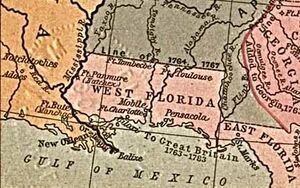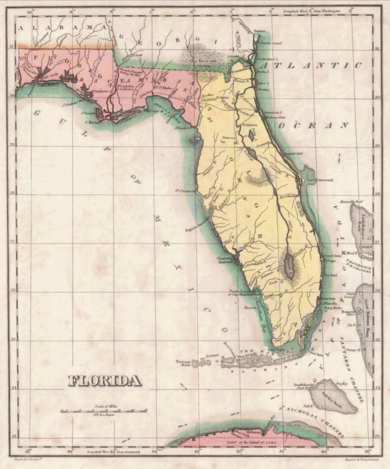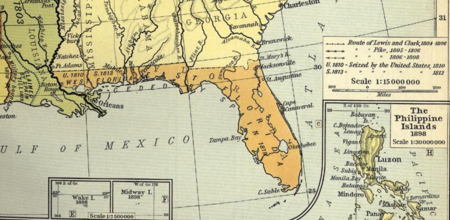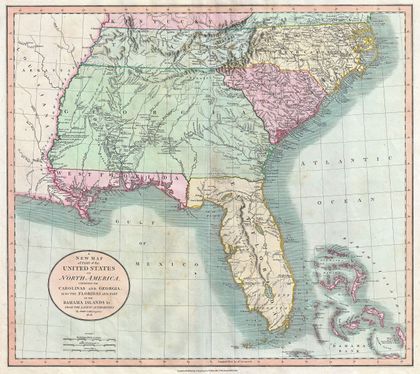غرب فلوريدا
| West Florida | |||||||||||||||||
|---|---|---|---|---|---|---|---|---|---|---|---|---|---|---|---|---|---|
| Territory Great Britain (1763–83), Spain (1783–1821). Areas disputed between Spain and United States from 1783–1795 and 1803–1821. | |||||||||||||||||
| 1763–1810 1810–1821 | |||||||||||||||||
 Flag | |||||||||||||||||
 British West Florida in 1767. | |||||||||||||||||
| العاصمة | Pensacola (1763) | ||||||||||||||||
| التاريخ | |||||||||||||||||
| الحكومة | |||||||||||||||||
| Governor | |||||||||||||||||
• 1763 | George Johnstone | ||||||||||||||||
| رئيس الوزراء | |||||||||||||||||
| التاريخ | |||||||||||||||||
| February 10 1763 | |||||||||||||||||
• Annexation by U.S. | December 10 1810 1810–1821 | ||||||||||||||||
| |||||||||||||||||
West Florida (إسپانية: Florida Occidental) was a region on the north shore of the Gulf of Mexico that underwent several boundary and sovereignty changes during its history. As its name suggests, it was formed out of the western part of former Spanish Florida (East Florida formed the eastern part, with the Apalachicola River the border), along with lands taken from French Louisiana; West Florida's capital was Pensacola. The colony included about 2/3 of what is now the Florida Panhandle, as well as parts of the modern U.S. states of Louisiana, Mississippi, and Alabama.
Great Britain established West and East Florida in 1763 out of land taken from France and Spain after the French and Indian War. As the newly acquired territory was too large to govern from one administrative center, the British divided it into two new colonies separated by the Apalachicola River. British West Florida's government was based in Pensacola; and the colony included the part of formerly Spanish Florida which lay west of the Apalachicola, plus parts of formerly French Louisiana. It thus comprised all territory between the Mississippi and Apalachicola Rivers, with a northern boundary which shifted several times over the subsequent years.
Both West and East Florida remained loyal to the British crown during the American Revolution, and served as havens for Tories fleeing from the Thirteen Colonies. Spain invaded West Florida and captured Pensacola in 1781, and after the war Britain ceded both Floridas to Spain. However, the lack of defined boundaries led to a series of border disputes between Spanish West Florida and the fledgling United States known as the West Florida Controversy.
Because of disagreements with the Spanish government, American and English settlers between the Mississippi and Perdido rivers declared that area as the independent Republic of West Florida in 1810. (None of the short-lived Republic lay within the borders of the modern U.S. state of Florida; it comprised the Florida parishes of today's Louisiana.) Within months it was annexed by the United States, which claimed the region as part of the Louisiana Purchase of 1803. In 1819 the United States negotiated the purchase of the remainder of West Florida and all of East Florida in the Adams–Onís Treaty, and in 1822 both were merged into the Florida Territory.
Colonial period

British era
Finding this new territory too large to govern as one unit, the British divided it into two new colonies, West Florida and East Florida, separated by the Apalachicola River, as set forth in the Royal Proclamation of 1763. East Florida consisted of most of the formerly Spanish Florida, and retained the old Spanish capital of St. Augustine. West Florida comprised the land between the Mississippi and Apalachicola Rivers, with Pensacola designated as its capital. The northern boundary was arbitrarily set at the 31st parallel north.[3]
Spanish era
Spain entered the American Revolutionary War on the side of France but not the Thirteen Colonies.[4] Bernardo de Gálvez, governor of Spanish Louisiana, led a military campaign along the Gulf Coast, capturing Baton Rouge and Natchez from the British in 1779, Mobile in 1780, and Pensacola in 1781.
Republic of West Florida

The United States and Spain held long, inconclusive negotiations on the status of West Florida. In the meantime, American settlers established a foothold in the area and resisted Spanish control. British settlers, who had remained, also resented Spanish rule, leading to a rebellion in 1810 and the establishment for 74 days of the Republic of West Florida.
American annexation of the territory

United States claim
By the secret treaty of October 1, 1800, between France and Spain, known as the St. Ildefonso treaty,[6] Spain returned to France in 1802 the province of Louisiana as at that time possessed by Spain, and such as it was when France last possessed it in 1769.[7]p 48[8] (In contrast, Madison's 1810 proclamation alluded to the time of France's original, not last, possession.)
Counters to the U.S. claim

- As part of the 1803 Louisiana Purchase treaty, France repeated verbatim Article 3 of its 1800 treaty with Spain, thus expressly subrogating the United States to the rights of France and Spain.[9]p 288-291
- In 1800, denominated Louisiana did not include West Florida.[9]p 288-291
- Spain in all negotiations with France refused to cede any part of Florida.[9]p 288-291
- In 1801 Spain informed the Spanish governors in North America that the territory ceded to France did not include West Florida.[1]p 87-88
- In Spanish government ordinances and treaties, the Floridas were always specified as distinct from all other Spanish possessions.[7]p 49-50
- France's 1801 Treaty of Aranjuez with Spain stipulated the cession of Louisiana to be a "restoration," not a retrocession.[7]p 50-52
- France never gave any part of Florida to Spain, so Spain could not give it back.[7]p 50-52
- In the time Spain held the Floridas, they were always called the Floridas and never referred to as a portion of Louisiana. Treaties between United States and Spain also called them the Floridas.[7]p 50-52
- In 1803 France began negotiating with Spain to acquire West and East Florida, confirming that France did not consider West Florida to have already been acquired.[7]p 50-52
- During his negotiations with France, U.S. envoy Robert Livingston wrote nine reports to Madison in which he stated that West Florida was not in the possession of France.[7]p 43-44
- President Jefferson asked U.S. officials in the border area for advice on the limits of Louisiana, the best informed of whom did not believe it included West Florida.[1]p 87-88
- When Louisiana was formally delivered to the United States, the U.S. did not demand possession of West Florida.[1]p 97-100
- In the summer of 1804, when the United States and Spain appealed to France to influence the treaty interpretation, Napoleon strongly sided with Spain.[1]p 109-110
- In November 1804, in response to Livingston, France declared the American claim to West Florida absolutely unfounded.[1]p 113-116
- In January 1805, the French and Spanish ambassadors jointly informed Madison that the American claim to West Florida was untenable. Madison pointed to pre-1763 maps that showed West Florida as part of the former French Louisiana territory. The French ambassador pointed out to Madison's dismay that the same applied to Tennessee and Kentucky.[1]p 116-117
- Upon the failure of Monroe's 1804–1805 special mission, Madison was ready to abandon the American claim to West Florida altogether.[1]p 118
- In 1805, Monroe's last proposition to Spain to obtain West Florida was absolutely rejected.[9]p 293
- In an 1809 letter, Jefferson virtually admitted that West Florida was not a possession of the United States.[7]p 46-47
- The U.S. title to the Louisiana territory was itself a vitiated title by virtue of the 1800 France-Spain treaty.[7]p 46
- General Andrew Jackson personally accepted the delivery of title to West Florida from its Spanish governor on July 17, 1821.[10]
Later history and legacy
The Spanish continued to dispute the annexation of the western parts of its West Florida colony, but their power in the region was too weak to do anything about it. They continued administering the remainder of the colony (between the Perdido and Suwannee Rivers) from the capital at Pensacola.
Governors
Governors under British rule:
- George Johnstone (1763–66)
- Montfort Browne (acting, 1766–1769)
- John Eliot (appointed 1767, arrived April 1769, committed suicide shortly afterward)
- Montfort Browne (acting, 1769)
- Elias Durnford (acting, 1769–1770)
- Peter Chester (1770–1781)
Governors under Spanish rule:
- Arturo O'Neill de Tyrone: (May 9, 1781 – 1794)
- Enrique White: (1794–1796)
- Francisco de Paula Gelabert: (1796)
- Vicente Folch y Juan: (June 1796 – March 1811)
- Francisco San Maxent: (March 1811 – 1812)
- Mauricio de Zúñiga: (1812–1813)
- Mateo González Manrique: (1813–1815)
- José de Soto: (1815–1816)
- Mauricio de Zúñiga: (1816)
- Francisco San Maxent: (1816)
- José Masot: (1816 – May 26, 1818)
- William King: (United States military governor, May 26, 1818 – February 4, 1819)
- José María Callava: (February 4, 1819 – July 17, 1821)
See also
- East Florida
- Republic of West Florida
- West Florida Controversy
- Alabama Territory
- Adams–Onís Treaty
- Spanish colonization of the Americas
- New Spain
- French colonization of the Americas
- New France
- British colonization of the Americas
- British North America
- Dominion of British West Florida (2005)
References
- ^ أ ب ت ث ج ح خ د Cox, Isaac Joslin (1918). The West Florida Controversy, 1798–1813 – a Study in American Diplomacy. Baltimore, Maryland: The Johns Hopkins Press.
- ^ خطأ استشهاد: وسم
<ref>غير صحيح؛ لا نص تم توفيره للمراجع المسماةSuwannee - ^ خطأ استشهاد: وسم
<ref>غير صحيح؛ لا نص تم توفيره للمراجع المسماةGannon - ^ Spencer Tucker; James R. Arnold; Roberta Wiener (سبتمبر 30, 2011). The Encyclopedia of North American Indian Wars, 1607–1890: A Political, Social, and Military History. ABC-CLIO. p. 751. ISBN 978-1-85109-697-8.
- ^ "Florida Parishes". Center for Southeast Louisiana Studies, Southeastern Louisiana University. Retrieved أكتوبر 24, 2015.
- ^ "Treaty of San Ildefonso : October 1, 1800". The Avalon Project. Yale Law School. Retrieved نوفمبر 16, 2015.
- ^ أ ب ت ث ج ح خ د ذ Chambers, Henry E. (مايو 1898). West Florida and its relation to the historical cartography of the United States. Baltimore, Maryland: The Johns Hopkins Press.
- ^ خطأ استشهاد: وسم
<ref>غير صحيح؛ لا نص تم توفيره للمراجع المسماةCharles - ^ أ ب ت ث Curry, J. L. M. (أبريل 1888). "The Acquisition of Florida". Magazine of American History. XIX: 286–301.
- ^ Ireland, Gordon (1941). Boundaries, possessions, and conflicts in Central and North America and the Caribbean. New York: Octagon Books. p. 298.
Bibliography
- Arthur, Stanley Clisby (1935). The Story of the West Florida Rebellion. St. Francisville, LA: St. Francisville Democrat. ISBN 1885480474.
{{cite book}}: Italic or bold markup not allowed in:|publisher=(help) — online here - Bice, David (2004). The Original Lone Star Republic: Scoundrels, Statesmen and Schemers of the 1810 West Florida Rebellion. Jacksonville: Heritage Publishing Consultants. ISBN 1-891647-81-4. OCLC 56994640.
- Cox, Isaac Joslin (1918). The West Florida Controversy, 1798–1813: A Study in American Diplomacy. Baltimore: Johns Hopkins University Press. OCLC 479174.
- Gannon, Michael (1996). The New History of Florida. University Press of Florida. ISBN 0-8130-1415-8.
- McMichael, Andrew (Spring 2002). "The Kemper 'Rebellion': Filibustering and Resident Anglo-American Loyalty in Spanish West Florida". Louisiana History. 43 (2): 140.
- McMichael, Andrew (2008). Atlantic Loyalties: Americans in Spanish West Florida, 1785–1810. University of Georgia Press. ISBN 978-0-8203-3004-4.
- Scallions, Cody (2011). "The Rise and Fall of the Original Lone Star State: Infant American Imperialism Ascendant in West Florida". Florida Historical Quarterly. 90 (2).
- West Florida Collection, Center for Southeast Louisiana Studies, Linus A. Sims Memorial Library, Southeastern Louisiana University, Hammond. For a summary of the holdings, click here.
وصلات خارجية
- British West Florida, by Robin Fabel (2007) at Encyclopedia of Alabama
- History of West Florida – Histories and Source Documents — includes full text of Arthur (1935) and other materials (compiled by Bill Thayer)
- "Not Merely Perfidious but Ungrateful": The U.S. Takeover of West Florida, by Robert Higgs (2005)
- West Florida, by Ann Gilbert (2003) <--Broken link, February 2017.
- Map of West Florida, 1806, by John Cary
- A Page of History from the Deepest of the Deep South – British West Florida, by Charlsie Russell (2006)
- The Sons & Daughters of the Province & Republic of West Florida 1763 – 1810 — Republic of West Florida descendants' organization
- Pages using gadget WikiMiniAtlas
- Use mdy dates from May 2013
- Former country articles requiring maintenance
- Pages using infobox former subdivision with unknown parameters
- Articles containing إسپانية-language text
- Pages using Lang-xx templates
- Articles with hatnote templates targeting a nonexistent page
- المقالات needing additional references from October 2017
- كل المقالات needing additional references
- CS1 errors: markup
- Coordinates on Wikidata
- West Florida
- 1783 establishments in New Spain
- 1821 disestablishments in New Spain
- 1821 disestablishments in the United States
- Colonial United States (Spanish)
- Former colonies in North America
- Former countries in North America
- Former regions and territories of the United States
- جمهوريات سابقة
- مستعمرات إسپانية سابقة
- بلدان سابقة غير معترف بها
- تاريخ الولايات المتحدة الجنوبية
- International territorial disputes of the United States
- New Spain
- Pre-statehood history of Alabama
- Pre-statehood history of Florida
- Pre-statehood history of Louisiana
- Pre-statehood history of Mississippi
- Spanish Florida
- States and territories disestablished in 1821
- دول وأقاليم تأسست في 1783

